Following its successful run at the National Museums of Scotland, this autumn saw the opening of the next phase of my collaborative exhibition Art of Glass at the National Centre for Craft and Design (NCCD), Sleaford.
Curated by Bryony Windsor the former head of exhibitions at NCCD, and myself, the exhibition is a snapshot of some of the most progressive artistic practice in glass being created in Britain today.
For NCCD we were excited to be able to develop the exhibition further, working directly with a number of the artists in the development of new works, expand installations, and showcase alternative works that reflect their most current practice, with two of the featured artists’ successful recipients of a Grant for the Arts from Arts Council of England, to develop new works especially for the second part of Art of Glass.
Erin Dickson
Erin Dickson was one of the two with her proposal Authentic Venetian Chandelier.
The concept of the work came following a visit to the Murano Glass Museum in Italy, where Erin was told she could not photograph a chandelier inside the gallery, but could take a crude scan on an iPad. This led her to conceive the idea of making her own Venetian glass chandelier from the scan, producing a full-size counterfeit using a 3D printer.
The work, pixelated and glitching as if the software has a fault, explores the notion of the digital copy, playing on a common misconception that 3D scanning and printing is easy and cheap. In reality, the knowledge and proficiency exercised in the realisation of digital craft, are as high and rare as traditional skills such as glassblowing.
Since starting the project Erin has made over 200 digital files available online for others to make their own chandelier. Providing a meditation on the perceived value of glass, and taking on the absurd notion that through piracy, one can own priceless objects.

The work arrived in a series of crates and had to be constructed section by section, by Erin and her assistant Kelsey over three days. Each arm of 3D printed chandelier had to be carefully filed then glued together before being fitted onto the main body and armature.
Erin with the assistance of a small team of helpers and technicians had spent over three months patiently working on the digital files, and 3D printing the sections that make up the final chandelier.
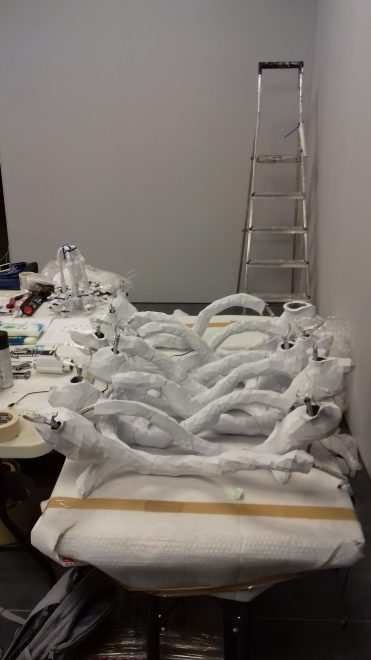
As the piece ‘grew’ in the space, you started to see the subtleties of the scan and execution of Erin’s digital craft. How the light had refracted in certain sections during the scan creating a higher pixel when digitally rendered, or a shadow had formed to define a feature of one of the dolphins that decorated the original Venetian chandelier in Murano.

Erin had taken the concept of ‘cheap’ computer-aided counterfeit one stage further by also creating a lighting programme that allowed the chandelier to light up in a way that made the work look like it had a glitch to its system. Emphasising the idea that the software that created it was insufficient to render it perfect.
The result is a wonderful artwork that challenges our perception of the skill, knowledge and craft exercised within digital creation. Authentic Venetian Chandelier is no cheap replica, but a twinkling, or should that be glitching, cyber homage to the traditions of Venetian glassblowing.

Emma Woffenden
The second recipient of a Grant for the Arts was leading British sculptor and glassmaker Emma Woffenden.
For the second part of Art of Glass Emma had proposed to create a larger installation that would draw on the darker side of the idea of the ideal domestic world.
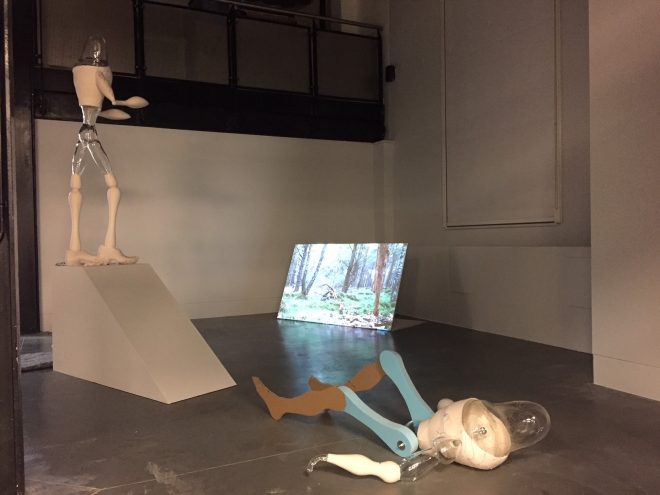
Featuring the original figure conceived for the first instalment of Art of Glass, Mummy Woodentop, is a statuesque figure that represents the absent virtues of the Mother. References are made to Emma’s own childhood and the late-20th-century children’s TV programme Watch with Mother, within the form of the spoon hands and the clogged feet, whilst the tattooed arms with symbols of femininity and virtue emphasise the concept of the ideal mother. Placing Mummy upon high, makes her both a dominant and present figure, but also remote and untouchable.
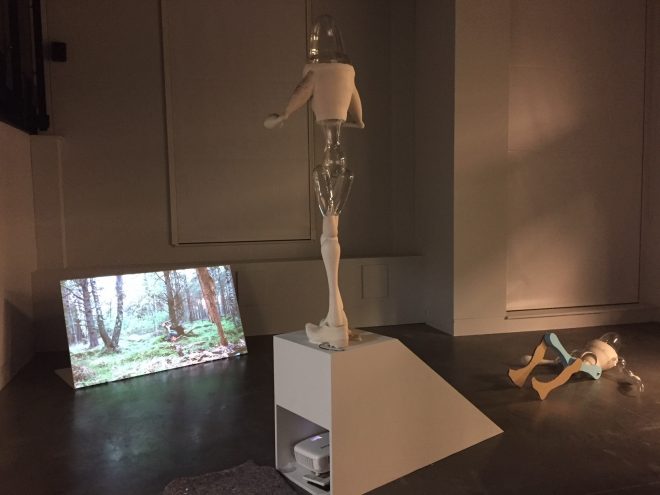
She is joined by a secondary figure that lies at the foot of the sloped plane on which Mummy stands. The position of this new figure creates a tension…or does she recline ambivalent of Mummy. Its mould blown head has wonderful delicate engraved strands of hair etched into its surface, whereas the lone eye is turned towards the film, quietly observing the performer’s interaction within the forest.
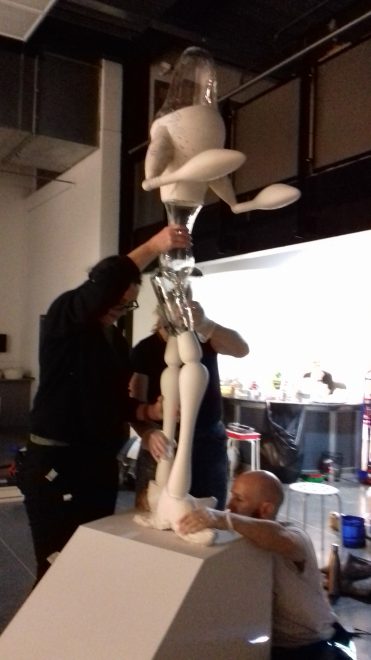
The film was created in collaboration with Ruth Maclennan and Robbie Synge, and is an ongoing artist collaboration which started in 2016 during Emma’s tenure as Artistic Director for Northlands Creative, Caithness. Within the film, the vertical rotten trunk reflects the standing figure and the rotten tree top that Robbie rolls with mirrors the lying down one. So, we see one scene imitating the other.
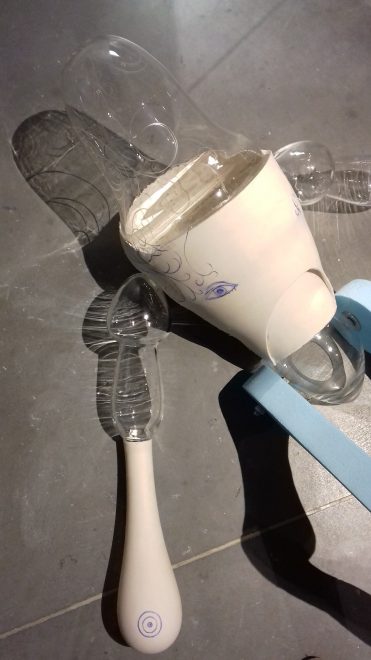
When I spoke to Emma about the piece and the importance of the film she said:
“as the tree is lifted and falls it also pushes and pulls the performer, both are animated by, and merge with each other. The eye of the filmmaker, the viewer and a standing sculpture, all watch the scene. We fell people and trees, integral to the installation are vertical and horizontal aspects, and the sense of falling.”
What Emma has created is a scene glimpsed through the lens of a child’s puppet show. A world of potential animosity or something that could easily be more innocent. The piece speaks of contact and separation, from people and from nature.
Helen Maurer
Due to the nature of the exhibition space at NCCD, we were able to invite a number of artists to expand their installations or create new pieces for Art of Glass.
The Jerwood Prize-winning artist Helen Maurer generously agreed to create a new installation from a body of work I had viewed at her studio in London the previous year.
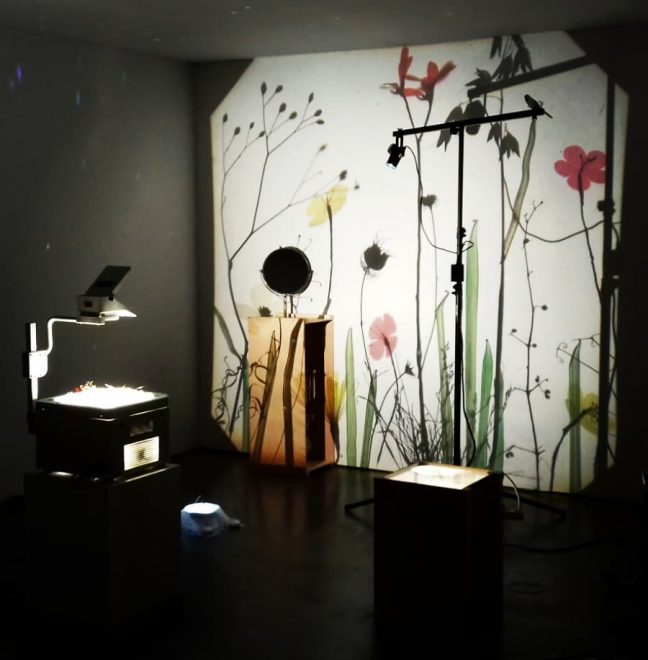
Entitled re Composing the work formed part of an installation which grew out of a commission for Holy Trinity Church, York, which was inspired by a piece of glass high up within the stained-glass windows, a hidden image of a “secret garden”.
As part of Helen’s practice, she works with a range of found objects and carefully created glass fragments to produce immersive installations. Here you can see Helen refocusing the light thrown from an overhead projector into a mirror to create a composition on the inner right wall.
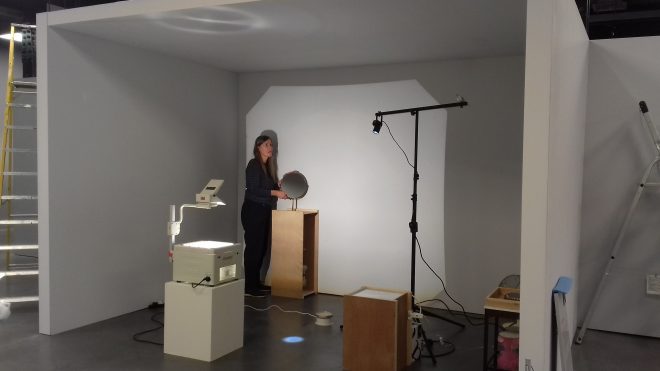
During the setup, she would walk around the space carefully adjusting the position of the objects she was working with so that they would reflect or refract the light to her ideal. She also carefully placed fans around the space to catch glass wind chimes and used lavender to fill the air with the scents of flowers.
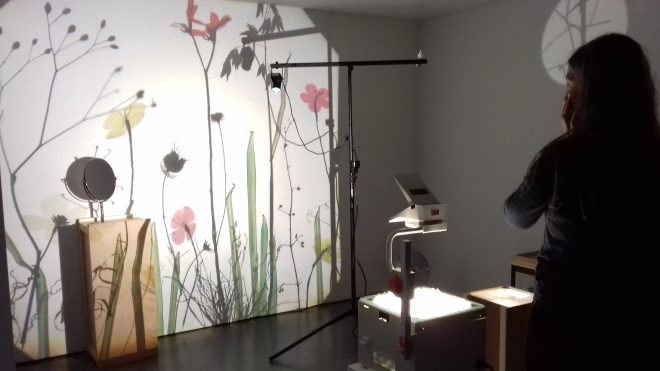
The result is a beautiful glass garden, replanted from its original sacred context to create new associations. And were we the viewer are immersed within this fragile composition, becoming part of a wider picture, standing within its light and sound.
Glass Cyphers
Griet Beyaert and Paul Miller, collectively known as Glass Cyphers, as is the title of their work, not only expanded the piece that was seen at National Museums Scotland, but created a new digital and sound score for NCCD.
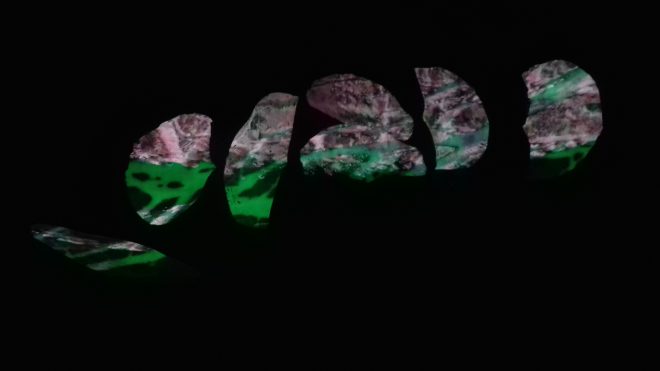
Griet and Paul use glass sculpture, sound and digital mapping to produce innovative, thought-provoking installations that reinterpret how we experience environments and space. They quite literally turn a lens onto spaces which are overlooked, taking sound recordings and video footage from an environment. These are then digitally altered and projected onto Griet’s specially created glass sculptures to create their mesmerising installations.
The process of creating the work on site is fascinating to watch. Griet very carefully hangs her delicate glass sculptures, in a formation that evokes the form and shape of the environment they are working in, whilst Paul carefully projection maps the pieces to allow for the digital animation and score to be projected upon the pieces precisely.
The result is a captivating artwork that draws the viewer in. You are mesmerised by the changing patterns of light, the sound waves moving through the pieces, and the glimpses of different environments they have captured on film.
I would like to thank Griet and Paul for travelling down from Leeds, via Manchester in the case of Paul, twice in-between two other exhibition installations to create the work for NCCD.
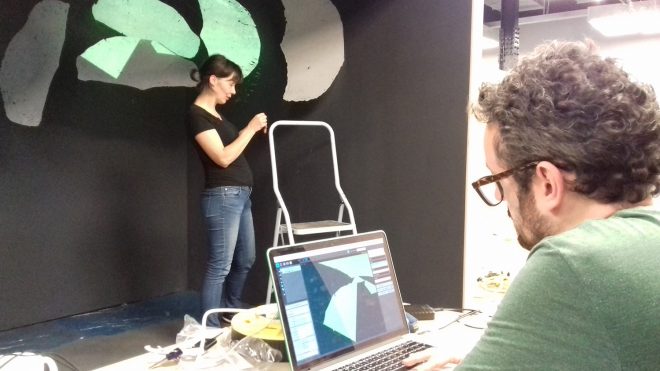
Rhian Hâf
For the second part of Art of Glass, both Bryony and myself were excited to be able to give the Welsh artist Rhian Hâf the space to exhibit two of her works that we had seen together last summer when we had visited Rhian at her studio in North Wales.
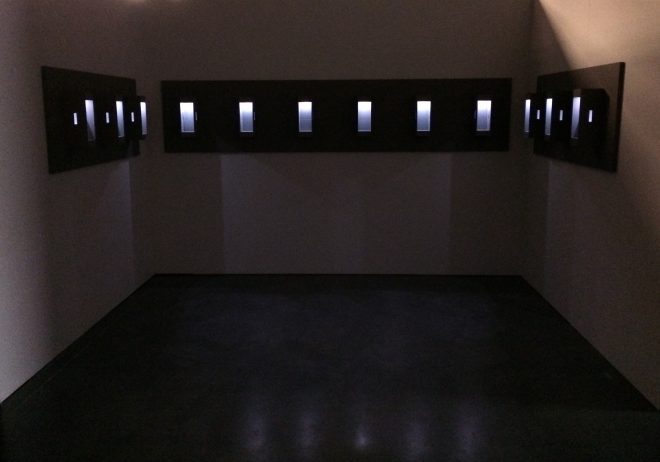
One of the pieces in question that was to be added to the exhibition, Captured Moments, had just returned from Rhian’s successful exhibition at Venice Glass Week in September 2018. The piece was developed and created with funding from the Arts Council of Wales following a residency in Venice, Italy in 2014, and was directly inspired by the shafts of light Rhian observed within the narrow Venetian alleyways, and the play of transient moments within architectural spaces in this luminous city.
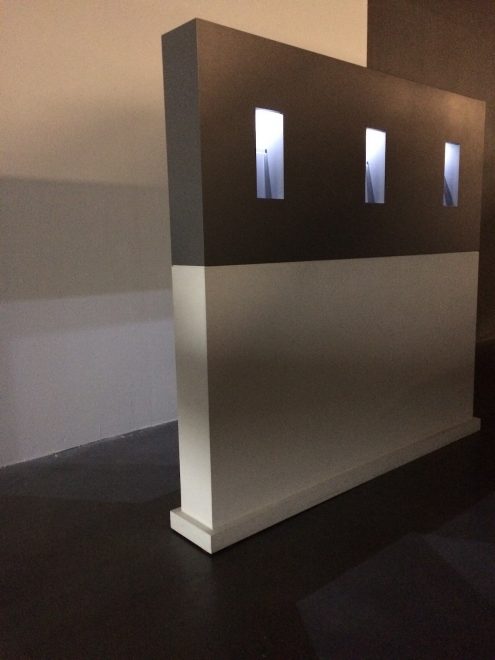
Rhian is internationally recognised for her work that captures fleeting moments of light and shadow; translating these ephemeral moments into visible static states and projections.
So, whilst one work travelled from Venice, Reflected Spaces which was seen at National Museums Scotland, travelled from Scotland, and met in Sleaford.

Here Rhian worked with the team to reconfigure Captured Moments for NCCD, juxtaposing Reflected Spaces to create new patterns of light and dark upon the screed floor.
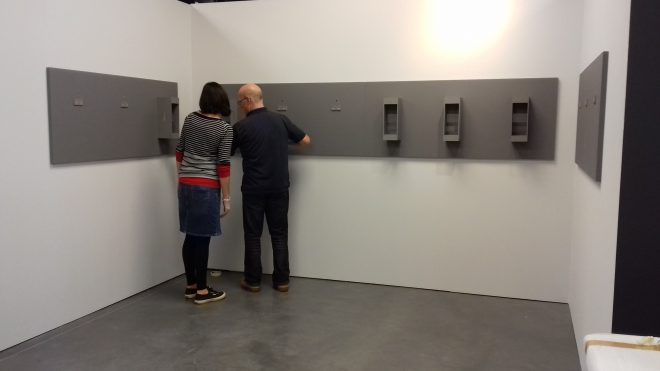
Each work holds a piece of optical glass that has been carefully ground and polished by Rhian to achieve a different reaction and refraction of light. The result is a striking dynamic composition of dark shadows and contrasting rays of reflected and refracted light, that fill the space with shafts of light that the viewer becomes immersed within.
Also featured in Art of Glass – NCCD are new works by the artists Gayle Matthias, Harry Morgan and Richard Wheater.
Gayle Matthias
Alongside Land Marks, seen at the National Museum of Scotland, Gayle Matthias created a new body of work entitled Drill Bits for NCCD. This work continues to draw upon her personal history and experience growing up around the potteries of Stoke on Trent; and the contrast between the environments and artefacts associated within her father’s car body repair garage, housed in former colliery baths, and her mother’s domestic existence. She intertwines discarded and found objects alongside cast and blown glass, to create a series of poignant autobiographical subjects that reflect the deterioration of the body and material value.
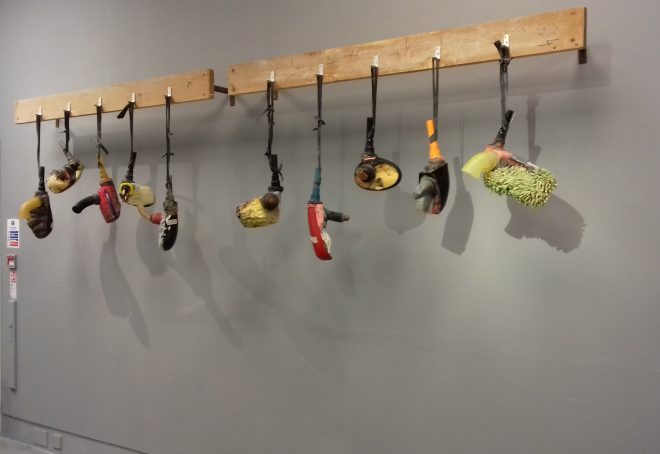
Richard William Wheater
Displayed nearby is a new work from Richard William Wheater’s ongoing series I’m Electric You’re Electric. These constructivist sculptures combine handblown glass elements with industrial hardware that are a response to how we contextualise electricity through objects of industry and technology, whilst simultaneously suggesting links to human nature. The title alludes to how a spark between two points of contact, or people, can create a connection both tangible and emotional.
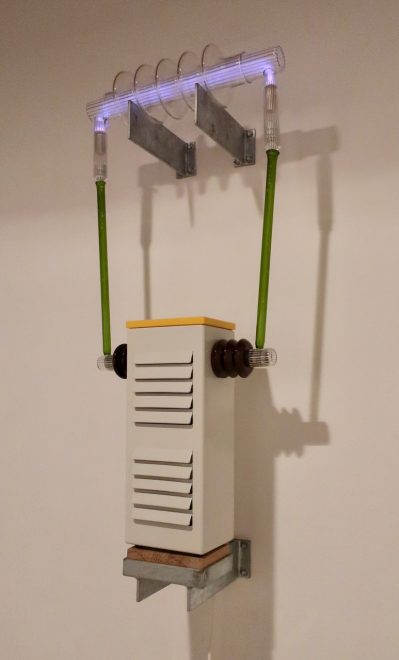
Harry Morgan
Whilst Harry Morgan has created a new monumental sculpture entitled Cuddle, which sees him pushing his practice of material experimentation to a new extreme. Harry uses traditional studio and industrial processes in order to position materials such as concrete and glass in such a way as to question the fragility of glass. For the new work we see the delicate glass stringers trapped within a column of concrete. The position is unnerving yet mesmerising, how does the glass hold the concrete, and how does it not snap in half.

I would also like to extend my thanks to the team at the National Centre for Craft & Design for their dedication to the project and working so hard during the install.
